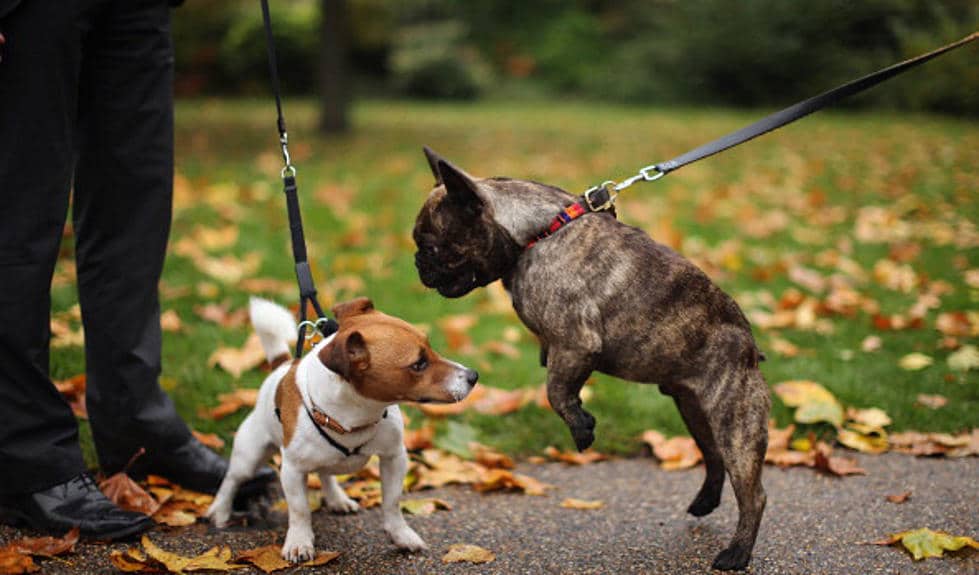Learning
How to Effectively Walk a Reactive Dog

There are some tricks that you might find come in handy when you are walking a reactive dog. When performing this feat, the dog will likely tug at the leash to chase nearby objects. He or she may bark or make a fuss about little issues. Certain measures can be put in place in order to avoid this type of occurrence which we will discuss in further detail in this article, however we strongly recommend to take reactive dog training courses.
Read more: Your Reactive Dog Can Get Better
Stick to the Same Route Everyday
You will want to stick to the same walking route for every single daily walking trip. Part of why your dog is so reactive to external factors is that he or she finds the environment unpredictable. This puts the dog on edge, causing him or her to want to bark or act out defensively.
It is perfectly possible to appease defensive behavior by eliminating the cause of the defensive sentiment in the first place. Dogs thrive upon a sense of familiarity. They will feel more at ease during their walk if they go on a walk in the same location every day.
This will lessen their feelings of the need to be defensive. They will slowly become comfortable with the environment in which you walk them if it is the same for every walk. As they begin to become acclimated to the specific environment, they will likely act out less.
Walk to an Actual Destination for Play
It would help if you walked to an actual destination, wherein the dog is able to play. Examples of this include a dog park or your yard at home. Having a destination in mind will help the dog to feel comfortable with taking a walk.
He or she will have an end goal in sight. This will offer him or her feeling of satisfaction and anticipation. This will also create a feeling of order.
At the conclusion of the walk itself, you may play a game with your dog that entails physical activity. This will allow the dog to get out some of the energy that he or she has. You may complete your walk at the dog park with a game of fetch.
Part of the reason that your dog is acting up is partial because he or she has an energy that they need to expend. All dogs require regular exercise, including fetch or running. This is a basic need for a dog and cannot be ignored.
It is imperative that you find a routine throughout your day wherein your dog can gain the exercise he or she needs. This is absolutely mandatory for any dog. It will increase his or her overall mood and will increase his overall physical well-being, as well.
Speak to the Dog While Walking
It would be best if you consistently were speaking to your dog throughout the entirety of the walk. This will make it less likely for your dog to act out in response to auditory cues. Instead of hearing a bird that he wants to chase, he will be focused on the sound of your voice.
It is important to speak to your dog throughout the walk so that he or she may maintain engagement with you and not forget that he or she is not alone. The dog may enjoy listening to the sound of your voice while taking a leisurely walk. This will encourage the dog to stay focused on the walk and not be distracted by noises or visual cues outside.
Use Dog’s Name throughout the Walk
When speaking to your dog throughout the walk, you may want to use your dog’s name in the conversation. You will want to remind your dog that his person is with him, and there will be no harm that can occur. You will frequently repeat your dog’s name while speaking to him in order to calm him down.
Dogs naturally experience a sense of calm and wellness when they hear their own name from their person. This will help the dog to keep his or her composure, despite seeing or hearing things on the walk. This will ensure that your dog remains calm throughout.
Tug on the Leash
You may want to make a small tug on the leash when your dog acts out. It would be best if you were not yanking your dog by the collar or the leash. This subtle tug of the leash is only noticeable enough to assist the dog and refrain from acting out.
This tug of the leash is not meant to hurt the dog. Rather, it is designed to act as a corrective behavior mechanism. When the dog feels this light tug of the leash, he or she will know that his reactive behavior was not appreciated by his or her person.
This tug of the leash should be just enough to draw attention to the dog, but not enough to cause any physical discomfort or harm. It is possible that, at times, you may have to stop the walk altogether, which will be initiated by a subtle tug of the leash. This should only be done if the dog exhibited extreme reactive behavior.
The Importance of Keeping Calm during Walk Time
There are so many reasons why it is important to keep calm during the walking time. This is a time when neighbors or those who live in the vicinity can become aware of a reactive dog. You will want to notify that close by that your dog is of good intentions and simply in the process of training.
This is a mandatory practice to notify those who live close by that your dog is safe and, in general, only reactive on walks. You will find that friends and neighbors will be especially understanding of the fact that your dog is still learning how to behave properly.




























